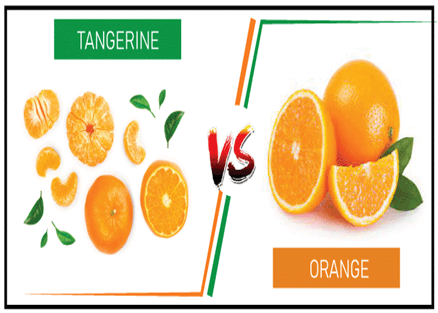Difference Between Orange and TangerineOranges and tangerines are two popular citrus fruits that are often confused with one another. However, there are some notable differences between the two when it comes to texture, colour, taste, and nutritional value. Oranges are a larger and thicker-skinned fruit with a flesh that is typically less juicy and slightly sweeter than tangerines. They are usually seedless or have a small number of seeds, making them a popular snack for both children and adults. Oranges are also a great source of vitamin C and fibre, making them a healthy addition to any diet. 
Tangerines, on the other hand, are smaller and thinner-skinned than oranges. They have a sweeter and more aromatic flavour and are often juicier, making them a popular choice for snacking or juicing. Tangerines are also seedless, making them a convenient option for those who prefer seedless fruit. Major Differences between Orange and TangerineOrigin: One major difference between the two fruits is their origin. Oranges are believed to have originated in China, while Tangerines, also known as Mandarin oranges, are a smaller and sweeter variety of orange and are believed to have originated in the Tangier region of Morocco. From China, the orange was spread throughout the world by traders and travellers, and today it is widely cultivated in many countries, including the United States, Spain, Brazil, and Italy. Commercial production of oranges and tangerines is ongoing all year long, with various types occasionally being made accessible during certain seasons. Between late October and January, tangerines are considered to be "in peak season" and at their most flavourful. In the months of November through March, oranges are "in season" and have the finest flavour. Family: The orange and tangerine belong to the citrus family, which includes a variety of popular fruit species such as lemons, limes, and grapefruits. This family is part of the larger plant family Rutaceae, which is known for producing a range of aromatic, juicy fruits. Skin: One of the most noticeable differences between oranges and tangerines is the skin. Oranges have thick, tough skin that can be difficult to peel, while tangerines have thin, easily-removable skin. This makes tangerines a more convenient option for snacking or adding to a fruit salad, while oranges are often used for juicing or cooking. Colour: Compared to tangerines, which have a slightly darker and more subdued orange hue; oranges have often a brighter, more vibrant orange colour. Taste: Oranges have a slightly sweeter and less aromatic flavour compared to tangerines, which are known for their sweet and fragrant taste. A citrus aftertaste will be there after eating either fruit, however, the aftertaste from tangerines is milder than that from oranges. Nutritional Value: Both oranges and tangerines are good sources of vitamin C, but tangerines have a higher concentration of this vital nutrient compared to oranges. Oranges, on the other hand, contain a higher amount of fibre and antioxidants, making them a good option for maintaining digestive health and fighting free radicals. When it comes to nutrition, both oranges and tangerines offer similar benefits, but there are some differences. For example, tangerines contain more Vitamin C than oranges, making them a better option for boosting your immune system. On the other hand, oranges contain more fibre and antioxidants, making them a good option for maintaining digestive health and fighting free radicals. In comparison to tangerines, which have 1.8 grams of soluble dietary fibre and nearly no fat, oranges have 2.4 grams, which is a little bit more. Tangerines have 53 calories per serving compared to 47 calories in an orange, which is a small amount more calories per serving. Oranges have 11.7 grams of carbohydrates, whilst tangerines have 13.3 grams. Tangerines likewise have a somewhat greater carbohydrate content than oranges. When compared to oranges, tangerines give 10% more of the daily necessary amount of vitamin A, with 14% as opposed to an orange's 4%. Oranges and tangerines each contain 5% of the daily recommended potassium consumption. Health Benefits of Oranges and TangerinesOranges and tangerines are one of the most popular and widely consumed fruits in the world. These citrus fruits are known for their sweet and tangy taste, as well as their many health benefits. Here are some of the key health benefits of oranges and tangerines:
Popular Dishes made from Orange and Tangerine
The best and quickest way to enjoy tangerines and oranges is to simply peel them. Both are fantastic choices for giving salads and salsas a zesty flavour. Choose ripe tangerines that are dark in colour and free of brown stains. Make sure the oranges are firm and have smooth-textured skin. ConclusionIn Conclusion, the orange and tangerine belong to the citrus family, which is known for producing a range of juicy, aromatic fruits. Both fruits are widely cultivated in many countries and are popular for their high vitamin C content, fiber, and antioxidants. Both oranges and tangerines have their own unique textures, colours, tastes, and nutritional values that set them apart from each other.
Next TopicDifference between
|
 For Videos Join Our Youtube Channel: Join Now
For Videos Join Our Youtube Channel: Join Now
Feedback
- Send your Feedback to [email protected]
Help Others, Please Share










